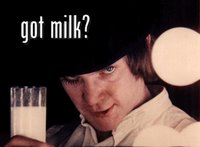Advertised with spray cans on abandoned buildings and government property is the wisdom that larger the car one owns the small is their reproductive organ. Initially intended to scare people off buying fuel guzzling SUVs by environmentalists (it used to be the best way until Bush fucked up Iraq, now they must be printing anti-SUV posters with massacred Iraqi children) this catchy has Darwinian undertones and supports an sperm competition theory.
All one has to do is make a small assumption that cars are analogous to horns on the head of the beetles, as in they serve the purpose of attracting mates. I don’t think this is such a great stretch. But just for skeptics, I would like to point to prevailing wisdom that the men with successful career get to mate more than unsuccessful ones, and a killer cars costs more which only successful men can afford. Also since in our society one can’t know a person if someone is actually successful by looking at his bank balance (OK. lets be materialist for a while, its easier to defend in evolutionary theory) one has to look at ‘markers’ for success. And that would be a fancy car or Armani suits. So these objects can be ‘weapons’ that help in attracting mates and securing a mating session.
Evolutionary theory predicts that organisms have limited resources that they can decide to use between having betters weapons of mate attraction and having better testis size. This was experimentally proved by group of scientists working on a genus of horned beetle. By cauterizing a group of cells in the larval stage, which would later become horns, they engineered beetles without horns. They found that they cauterized males has disproportionately large testes.
It doesn’t sound very intuitive to think that resources that can be used to further the genetic cause (sperm production) are diverted to make better weapons, which are for attracting mates. But one can argue that attracting a mate is the logical first step in furthering ones genes, but why does it have to be done at the expense of all important sperm production?
To think of this in terms of probabilities, what is the probability that an organism will be able to have an offspring with average attracting capabilities and very large amount of ejaculate? Is this probability lower than the probability of having offspring when an organism has lower sperm count and very large attraction capabilities?May be the weapons can influence the frequency of mating encounters and make up for the lower sperm count from lower resource allocation for testis. We dont know for sure if having bigger horns is better or bigger testis is.
The resource allocation conundrum that these organisms face seem to be a developmental phenomenon, where body parts that were closer in the larval stage have more competition for the same resources and resulting trade-off in their morphology. According to this theory the authors have predicted that the trade off effect would be more pronounced in species that have horns from their thorax rather than the head, as its farther way in the developing tissue.
But surveying the natural population of 25 species for this trade off between horns and testes, the authors did not find any significant relationship between the two. But other observations like evolution of an extra thoracic horn in species, which have less mating competition show that sperm competition constrains origin of new horns.
This paper gives a fascinating insight into development of secondary sexual characters and the important role it plays in sperm competition and evolutionary success. Also the perplexing thought that evolution has to choose between male investment in gaining matings and fertilizations.


 In an example of reverse technology transfer, a leading stem cell researcher from MIT has used our very own indigenous techinque of hunger strike to further his own cause. Experts from India point out that this technique, when used in right concentration and with close physiological monitoring could be a sure shot success.
In an example of reverse technology transfer, a leading stem cell researcher from MIT has used our very own indigenous techinque of hunger strike to further his own cause. Experts from India point out that this technique, when used in right concentration and with close physiological monitoring could be a sure shot success.
 Mystery of the exploding custard factories explained.
Mystery of the exploding custard factories explained. 
